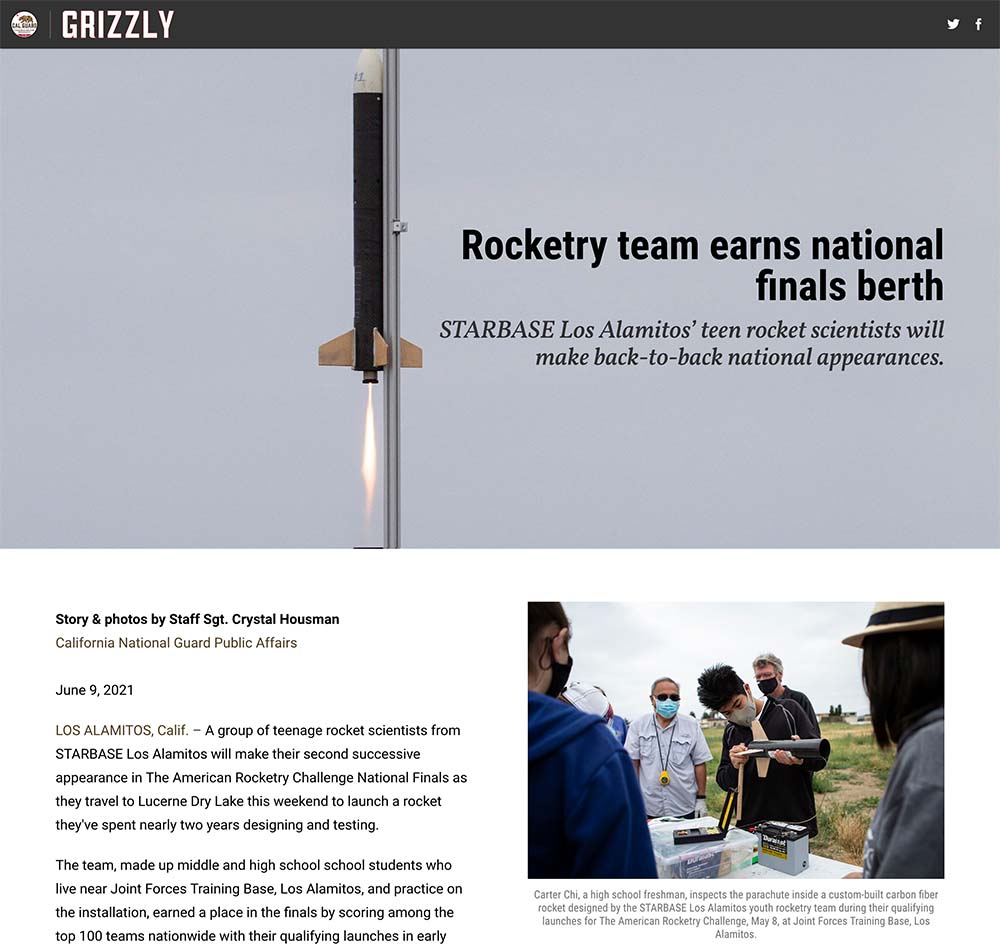STARBASE Los Alamitos rocket team ready for national finals
Southern California teens head to Virginia for third consecutive appearance in the American Rocketry Challenge national finals
Story and photos by Staff Sgt. Crystal Housman
California National Guard Public Affairs
May 11, 2022
LOS ALAMITOS, Calif. – In May 2019, the STARBASE Los Alamitos youth rocketry team walked off a 380-acre field in Virginia with some experience under their belt and a chip on their shoulder.
They vowed to return to the place where they finished 52nd out of 100 teams in the American Rocketry Challenge National Finals, narrowly missing an afternoon fly-off between the 50 best middle and high school rocketry teams in the country.
Three school years and a global pandemic later, the team returns to the Great Meadow event center, May 14, to continue a relentless pursuit of becoming the best youth rocket scientists in the U.S.
"The goal is to win," Gina Rodeghiero said matter-of-factly. The sixteen-year-old high school sophomore joined the team as a fifth grader and has spent countless afternoons and weekends at the STARBASE campus on Joint Forces Training Base, Los Alamitos, for after-school rocket design and production lab.
The American Rocketry Challenge scores participants based on accuracy to a prescribed launch altitude and flight duration with the requirement that all launches safely return a payload of raw hen's eggs. Any deviations over or under the specifications are assessed a point, and the lowest scoring team wins.
The STARBASE Los Alamitos team spent months designing and building a competitive rocket for the 2020 competition, only to have the event postponed a year when COVID-19 swept the country.
"When COVID happened, that's when everything changed," said California State Guard Chief Warrant Officer 2 Stacey Hendrickson, who serves as director of STARBASE Los Alamitos.
"I feel like this group had the passion, they had the commitment, and they had the love for it," Hendrickson said.
The team stayed together through the pandemic. They designed another rocket from scratch for the 2021 competition and earned a second national finals berth as the pandemic began to wane.
To safely follow federal, state, and local health guidance, competition organizers created a series of regional finals for 2021's top 100 teams. The STARBASE team made their finals launch on a dry lake bed in the Mojave Desert on a 91-degree day in June.
An extended delay on the launch pad combined with the increasing summer temperature threw off the rocket's performance against the team's calculations. They recorded a higher score than the team was used to and a higher score than they expected.
"Their expectations are very high," said Jacob Wiedner, a STARBASE Los Alamitos STEM instructor who also mentors the rocket team.
They cracked the top 50 and finished 48th overall, but this time there was no afternoon fly-off to vie for a better finish.
"I felt like they weren't going to be happy unless they got their best score of the season in finals," Hendrickson said. "If you can do it, you want to do it when it counts. If that's what you can do, you can't rest until you do it when it counts the most."
When registration for the 2022 contest opened in September, the team got back to work.
They used computer aided design software and rocket simulation software to design a modular rocket made almost entirely of custom-built parts. They rolled their own carbon fiber body tubes in two sizes, used an industrial water jet cutter to craft a removable fin system, and 3D printed nose cones and body tube transition parts from their designs.
Wiedner, a third-year mechanical engineering student at nearby California State University, Long Beach, taught the team to research and write critical design reports for every aspect of the rocket. Every detail was thought out, but implementing the design was not without its difficulties.
"One of the things we did earlier in the year was make a removable fin system in case we ever wanted to swap out broken fins or replace them. That ended up bringing us a lot of challenges that we didn't initially realize," Rodeghiero said. "After we were able to get the design figured out, it ended up being really nice and really easy. That was definitely a big challenge."
Another twist in the 2022 competition – horizontal egg placement – created additional engineering considerations, she said.
Donations from a Chance for Children and the Society of Military Engineers, Orange County Post, enabled the team to fly more than 60 launches to dial-in their design for the 2022 competition. Data collected from the first ten or fifteen launches helped them define the rocket's coefficient of drag and hone their simulation software to the actual rocket as built.
The team flew qualifying launches at a model aircraft field in Norco, and in early April, the team received its third consecutive National Finals invitation after recording a pair of launches that flew close to the target of 835 feet and scored among the top 101 teams nationwide.
Armed with three more years of engineering and rocketry experience, the teens are finally heading back to Great Meadow.
"I feel like they've got to have their skills seen before they could feel like it wasn't unfinished business," Hendrickson said.
For Paige Jones, a high school senior and the team's eldest member, the journey has been a good one.
"It's fun to know that we were able to make it three times in a row just to get to the finals," Jones said. "That makes us happy."
Rodeghiero says she is "very excited" for a return to Great Meadow and wants to win, but there's another goal at hand.
"The goal is definitely to learn as much as possible," she said. The teens are eyeing larger competitions for next year and the experience they gain in 2022 will be critical. A good finish at Great Meadow may mean an invitation to one of those competitions next year.
"That's the ultimate goal," Rodeghiero said. "We'll have a lot of opportunities to explore aspects of rocketry that we've never been able to."
STARBASE Los Alamitos is one of two Department of Defense STARBASE locations facilitated by the California Military Department under the banner of Cal Guard's Task Force Torch youth and community programs directorate. The program focuses exposing fifth graders to the technological environments and positive civilian and military role models, while also hosting a follow-on programs like rocketry for middle and high school students.
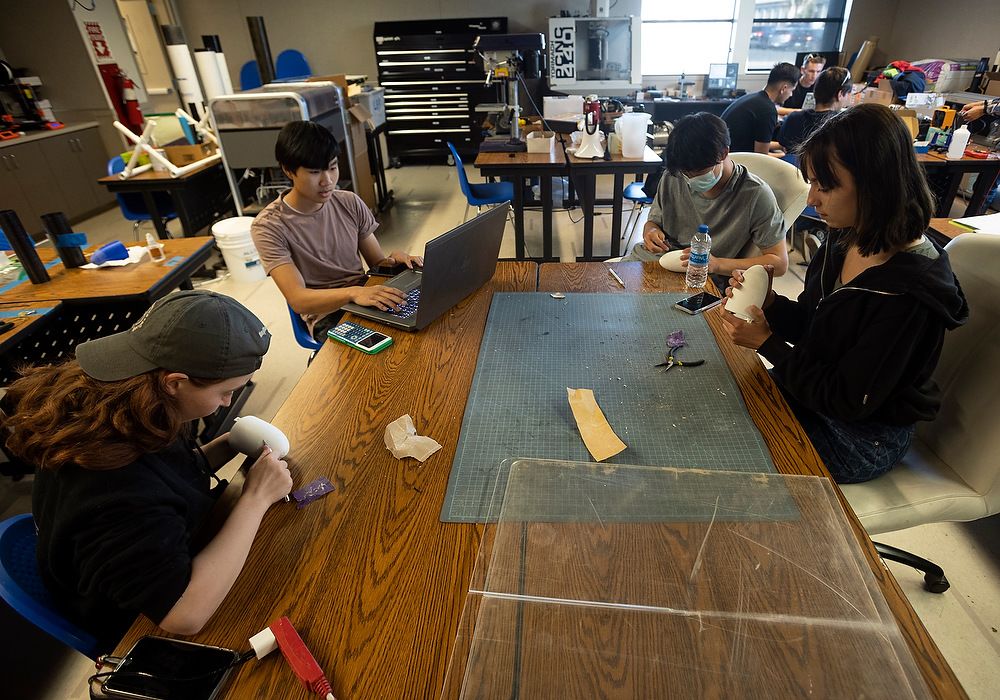
Members of the STARBASE Elite rocketry team at STARBASE Los Alamitos smooth out 3D printed nose cones and prepare for a weekend practice launch, April 29, at Joint Forces Training Base, Los Alamitos.
Members of the STARBASE Elite rocketry team at STARBASE Los Alamitos smooth out 3D printed nose cones and prepare for a weekend practice launch, April 29, at Joint Forces Training Base, Los Alamitos.
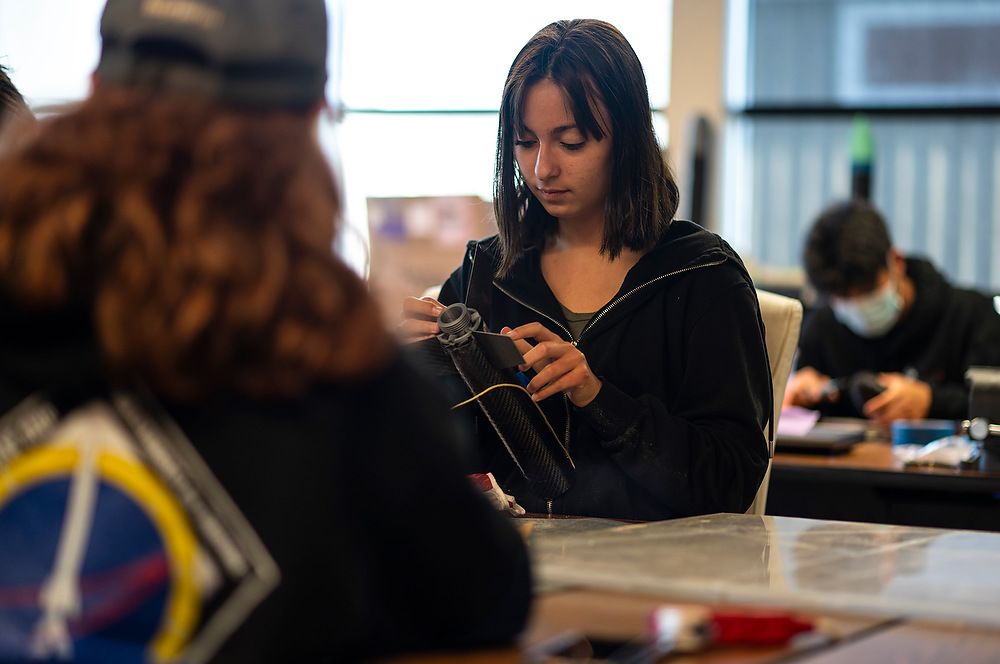
Gina Rodeghiero, 16, a high school sophomore, inspects the removable fin system for the STARBASE Los Alamitos competition rocket.
Gina Rodeghiero, 16, a high school sophomore, inspects the removable fin system for the STARBASE Los Alamitos competition rocket.

A removable fin system designed by the STARBASE Los Alamitos rocketry team proved challenging at first, but has since given team members the ability to swap rocket parts quickly and with ease.
A removable fin system designed by the STARBASE Los Alamitos rocketry team proved challenging at first, but has since given team members the ability to swap rocket parts quickly and with ease.

Dalton Chi, 15, a high school freshman, right, and junior Timothy Huang, 16, left, inspect various parts of the STARBASE Los Alamitos modular rocket, April 29, during an after-school session to prepare for a weekend practice launch the next day.
Dalton Chi, 15, a high school freshman, right, and junior Timothy Huang, 16, left, inspect various parts of the STARBASE Los Alamitos modular rocket, April 29, during an after-school session to prepare for a weekend practice launch the next day.
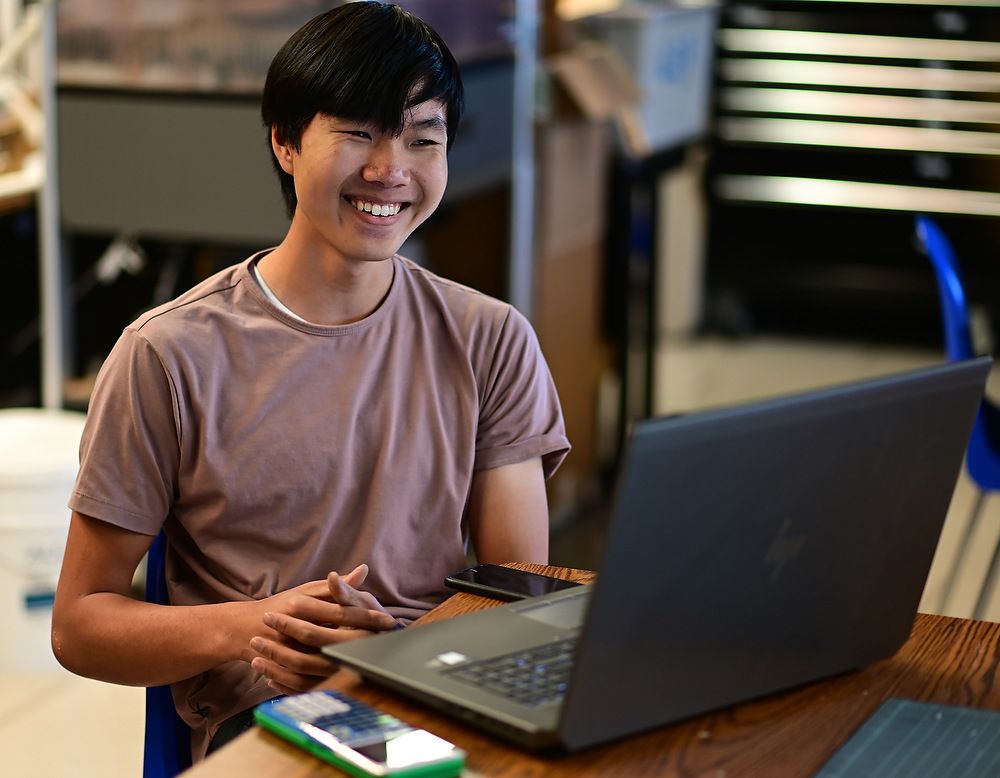
Timothy Huang, 16, a high school junior, laughs with teammates while calculating weights and updating a spreadsheet that lists each part of the team's modular rocket design.
Timothy Huang, 16, a high school junior, laughs with teammates while calculating weights and updating a spreadsheet that lists each part of the team's modular rocket design.
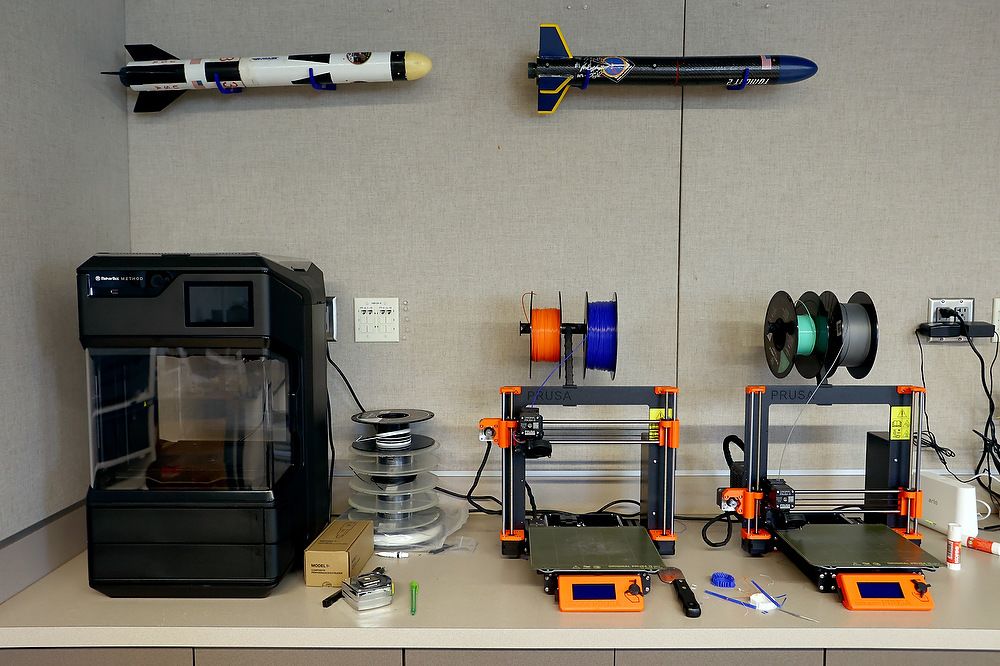
The past two STARBASE Los Alamitos American Rocketry Challenge National Finals qualifying rockets are mounted to the wall inside a classroom at the STARBASE campus on Joint Forces Training Base, Los Alamitos. At left is a rocket the team flew in during the 2019 National Finals in Virginia, and at right is their 2021 rocket flown during a regional finals in the Mojave Desert.
The past two STARBASE Los Alamitos American Rocketry Challenge National Finals qualifying rockets are mounted to the wall inside a classroom at the STARBASE campus on Joint Forces Training Base, Los Alamitos. At left is a rocket the team flew in during the 2019 National Finals in Virginia, and at right is their 2021 rocket flown during a regional finals in the Mojave Desert.
RELATED COVERAGE
(June 9, 2021) – STARBASE Los Alamitos rocketry team earns national finals berth. Teen rocket scientists will make back-to-back national appearances in The American Rocketry Challenge. Link opens in new window.
(June 9, 2021) – STARBASE Los Alamitos rocketry team earns national finals berth. Teen rocket scientists will make back-to-back national appearances in The American Rocketry Challenge. Link opens in new window.



